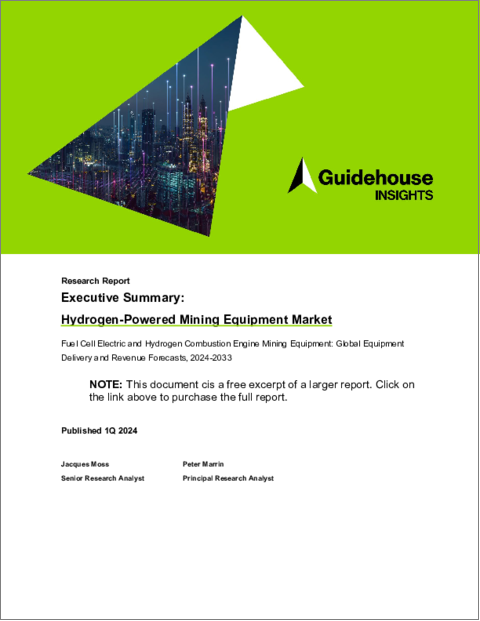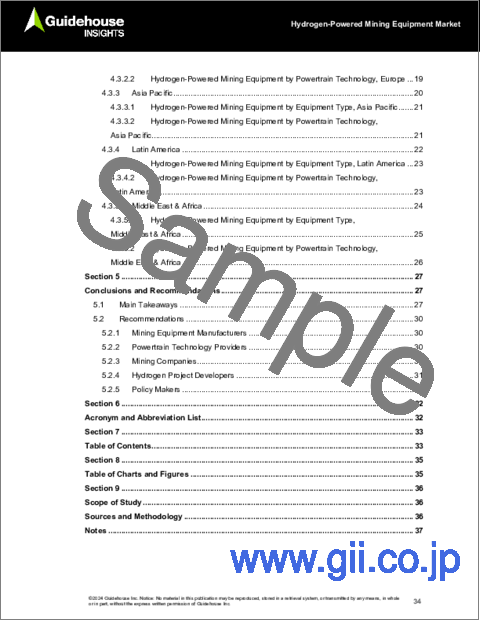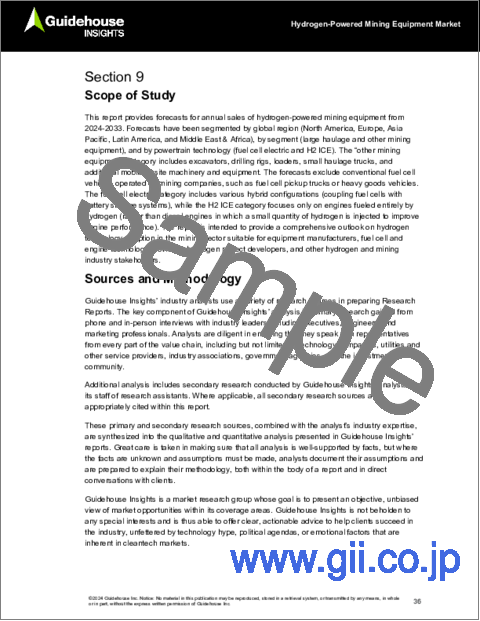|
|
市場調査レポート
商品コード
1455658
水素動力式鉱山機械の世界市場 - 燃料電池型電動式および水素燃焼エンジン式の鉱山機械:世界の装置納入台数と収益予測 (2024~2033年)Hydrogen-Powered Mining Equipment Market - Fuel Cell Electric and Hydrogen Combustion Engine Mining Equipment: Global Equipment Delivery and Revenue Forecasts, 2024-2033 |
||||||
|
|||||||
| 水素動力式鉱山機械の世界市場 - 燃料電池型電動式および水素燃焼エンジン式の鉱山機械:世界の装置納入台数と収益予測 (2024~2033年) |
|
出版日: 2024年03月26日
発行: Guidehouse Research
ページ情報: 英文 38 Pages; 41 Tables, Charts & Figures
納期: 即納可能
|
全表示
- 概要
- 図表
- 目次
鉱山企業は、非化石エネルギー源への移行において重要な役割を担っています。鉱業は、クリーンエネルギー技術の製造に必要な原材料を提供する一方で、CO2排出源としても重要な役割を果たしています。採掘事業からの排出量の半分弱は、大型の採掘車両や機器でのディーゼル消費によるものです。運搬トラックは最大の燃料使用者であり、年間約6,800万トンのCO2排出を占めています。
世界の主要な採掘業者のほとんどは、気候変動戦略を発表しており、通常、2040年代と2050年代に気候変動中立目標を設定し、操業時の排出量を対象としています。鉱山機械やパワートレインのサプライヤーと協力して、これらの企業は現在、運搬トラック、掘削機、ローダー、掘削装置、その他の現場設備を脱炭素化するためのさまざまなソリューションを模索しています。ほとんどの代替経路とは異なり、水素は採掘業者に、燃料を現場で生産することも、第三者サプライヤーから調達することもできる柔軟性を用意します。また、燃料補給にかかる時間が短く、出力密度が高く、航続距離もバッテリー電気ソリューションより長い可能性があります。しかし、完全な電気経路と比較すると、水素技術の往復効率は低いため、通常、運用コストは高くなります。そのため、一部の顕著な例外を除き、鉱業関係者は水素技術への投資に慎重な姿勢を見せています。
当レポートでは、世界の水素動力式鉱山機械市場の2024~2033年における販売台数・収益を、地域別・装置の種類別・パワートレイン技術別に予測しております。また、鉱山企業や装置サプライヤーの概略を調査し、電動式と水素動力式の脱炭素経路のトレードオフ関係について検討し、水素技術と鉱業のバリューチェーン全体の利害関係者への提言を提供いたします。
目次
第1章 エグゼクティブサマリー
第2章 市場の問題
- 促進要因
- 抑制要因
- エネルギー転換による物質需要の増加
- 鉱石の品質低下による影響
- 採掘作業からの排出源
- パワートレイン技術
第3章 業界のバリューチェーン
- 装置・技術プロバイダー
- 鉱山企業
第4章 市場予測
- 分析手法
- 世界の市場概要
- 水素動力式鉱山機械:地域別
- 水素動力式鉱山機械:装置の種類別
- 水素動力式鉱山機械:パワートレイン技術別
- 市場予測:地域別
- 北米
- 欧州
- アジア太平洋
- ラテンアメリカ
- 中東・アフリカ
第5章 結論・提言
- 主な要点
- 推奨事項
- 鉱山機械メーカー
- パワートレイン技術プロバイダー
- 鉱山企業
- 水素プロジェクト開発者
- 政策立案者
第6章 頭字語と略語のリスト
第7章 目次
第8章 図表
第9章 分析範囲
第10章 情報源、分析手法、注記
List of Tables
- Hydrogen-Powered Mining Equipment Deployments by Region, World Markets, 2024-2033
- Hydrogen-Powered Mining Equipment Revenue by Region, World Markets, 2024-2033
- Hydrogen-Powered Mining Equipment Deployments by Equipment Type, World Markets, 2024-2033
- Hydrogen-Powered Mining Equipment Revenue by Equipment Type, World Markets, 2024-2033
- Hydrogen-Powered Mining Equipment Deployments by Powertrain Technology, World Markets, 2024-2033
- Hydrogen-Powered Mining Equipment Revenue by Powertrain Technology, World Markets, 2024-2033
- Hydrogen-Powered Mining Equipment Deployments by Equipment Type, North America, 2024-2033
- Hydrogen-Powered Mining Equipment Revenue by Equipment Type, North America, 2024-2033
- Hydrogen-Powered Mining Equipment Deployments by Powertrain Technology, North America, 2024-2033
- Hydrogen-Powered Mining Equipment Revenue by Powertrain Technology, North America, 2024-2033
- Hydrogen-Powered Mining Equipment Deployments by Equipment Type, Europe, 2024-2033
- Hydrogen-Powered Mining Equipment Revenue by Equipment Type, Europe, 2024-2033
- Hydrogen-Powered Mining Equipment Deployments by Powertrain Technology, Europe, 2024-2033
- Hydrogen-Powered Mining Equipment Revenue by Powertrain Technology, Europe, 2024-2033
- Hydrogen-Powered Mining Equipment Deployments by Equipment Type, Asia Pacific, 2024-2033
- Hydrogen-Powered Mining Equipment Revenue by Equipment Type, Asia Pacific, 2024-2033
- Hydrogen-Powered Mining Equipment Deployments by Powertrain Technology, Asia Pacific, 2024-2033
- Hydrogen-Powered Mining Equipment Revenue by Powertrain Technology, Asia Pacific, 2024-2033
- Hydrogen-Powered Mining Equipment Deployments by Equipment Type, Latin America, 2024-2033
- Hydrogen-Powered Mining Equipment Revenue by Equipment Type, Latin America, 2024-2033
- Hydrogen-Powered Mining Equipment Deployments by Powertrain Technology, Latin America, 2024-2033
- Hydrogen-Powered Mining Equipment Revenue by Powertrain Technology, Latin America, 2024-2033
- Hydrogen-Powered Mining Equipment Deployments by Equipment Type, Middle East & Africa, 2024-2033
- Hydrogen-Powered Mining Equipment Revenue by Equipment Type, Middle East & Africa, 2024-2033
- Hydrogen-Powered Mining Equipment Deployments by Powertrain Technology, Middle East & Africa, 2024-2033
- Hydrogen-Powered Mining Equipment Revenue by Powertrain Technology, Middle East & Africa, 2024-2033
List of Figures
- Hydrogen-Powered Mining Equipment Deployments and Revenue by Region, World Markets, 2024-2033
- Hydrogen-Powered Mining Equipment Deployments and Revenue by Region, World Markets, 2024-2033
- Hydrogen-Powered Mining Equipment Deployments and Revenue by Equipment Type, World Markets, 2024-2033
- Hydrogen-Powered Mining Equipment Deployments and Revenue by Powertrain Technology, World Markets, 2024-2033
- Hydrogen-Powered Mining Equipment Deployments and Revenue by Equipment Type, North America, 2024-2033
- Hydrogen-Powered Mining Equipment Deployments and Revenue by Powertrain Technology, North America, 2024-2033
- Hydrogen-Powered Mining Equipment Deployments and Revenue by Equipment Type, Europe, 2024-2033
- Hydrogen-Powered Mining Equipment Deployments and Revenue by Powertrain Technology, Europe, 2024-2033
- Hydrogen-Powered Mining Equipment Deployments and Revenue by Equipment Type, Asia Pacific, 2024-2033
- Hydrogen-Powered Mining Equipment Deployments and Revenue by Powertrain Technology, Asia Pacific, 2024-2033
- Hydrogen-Powered Mining Equipment Deployments and Revenue by Equipment Type, Latin America, 2024-2033
- Hydrogen-Powered Mining Equipment Deployments and Revenue by Powertrain Technology, Latin America, 2024-2033
- Hydrogen-Powered Mining Equipment Deployments and Revenue by Equipment Type, Middle East and Africa, 2024-2033
- Hydrogen-Powered Mining Equipment Deployments and Revenue by Powertrain Technology, Middle East and Africa, 2024-2033
Pictorial Representation of the Industry Value Chain
Mining companies have an important role to play in the transition to non-fossil energy sources. While the industry provides the raw materials needed for the manufacture of clean energy technologies, it is also a significant source of CO2 emissions. A little under half of the emissions from mining operations come from diesel consumption in heavy duty mining vehicles and equipment. Haulage trucks are the largest fuel users, accounting for approximately 68 million tons of CO2 emissions per annum.
Most of the world's major mining players have released climate strategies, typically covering operational emissions with climate neutrality goals set for the 2040s and 2050s. Working in tandem with mining equipment and powertrain suppliers, these companies are currently exploring a range of solutions to decarbonize haulage trucks, excavators, loaders, drilling rigs, and other onsite equipment. Unlike most alternative pathways, hydrogen offers mining players the flexibility to produce fuel onsite or procure it from third-party suppliers. It also presents faster refueling times, increased power density and greater range potential than battery electric solutions. However, the low round trip efficiency of hydrogen technologies compared to fully electric pathways typically entails higher operational costs. With some notable exceptions, mining players are therefore taking a cautious approach to investing in hydrogen technologies.
This Guidehouse Insights report forecasts hydrogen-powered mining equipment sales and revenues from 2024-2033, segmented by global region, equipment type, and powertrain technology. It provides a detailed overview of mining players and equipment suppliers, discusses some of the tradeoffs between electrification and hydrogen-based decarbonization pathways, and offers recommendations to stakeholders across the hydrogen technology and mining value chains.
Table of Contents
1. Executive Summary
- 1.1 Market Introduction
- 1.2 Market Forecast
2. Market Issues
- 2.1 Drivers
- 2.2 Barriers
- 2.3 Increasing Material Demands from the Energy Transition
- 2.4 Impact of Declining Ore Grades
- 2.5 Sources of Emissions from Mining Operations
- 2.6 Powertrain Technologies
3. Industry Value Chain
- 3.1 Equipment and Technology Providers
- 3.2 Mining Companies
4.Market Forecasts
- 4.1 Methodology
- 4.2 Global Market Overview
- 4.2.1 Hydrogen-Powered Mining Equipment by Region
- 4.2.2 Hydrogen-Powered Mining Equipment by Equipment Type
- 4.2.3 Hydrogen-Powered Mining Equipment by Powertrain Technology
- 4.3 Regional Market Forecasts
- 4.3.1 North America
- 4.3.1.1 Hydrogen-Powered Mining Equipment by Equipment Type, North America
- 4.3.1.2 Hydrogen-Powered Mining Equipment by Powertrain Technology, North America
- 4.3.2 Europe
- 4.3.2.1 Hydrogen-Powered Mining Equipment by Equipment Type, Europe
- 4.3.2.2 Hydrogen-Powered Mining Equipment by Powertrain Technology, Europe
- 4.3.3 Asia Pacific
- 4.3.3.1 Hydrogen-Powered Mining Equipment by Equipment Type, Asia Pacific
- 4.3.3.2 Hydrogen-Powered Mining Equipment by Powertrain Technology, Asia Pacific
- 4.3.4 Latin America
- 4.3.4.1 Hydrogen-Powered Mining Equipment by Equipment Type, Latin America
- 4.3.4.2 Hydrogen-Powered Mining Equipment by Powertrain Technology, Latin America
- 4.3.5 Middle East & Africa
- 4.3.5.1 Hydrogen-Powered Mining Equipment by Equipment Type, Middle East & Africa
- 4.3.5.2 Hydrogen-Powered Mining Equipment by Powertrain Technology, Middle East & Africa
- 4.3.1 North America
5. Conclusions and Recommendations
- 5.1 Main Takeaways
- 5.2 Recommendations
- 5.2.1 Mining Equipment Manufacturers
- 5.2.2 Powertrain Technology Providers
- 5.2.3 Mining Companies
- 5.2.4 Hydrogen Project Developers
- 5.2.5 Policy Makers





